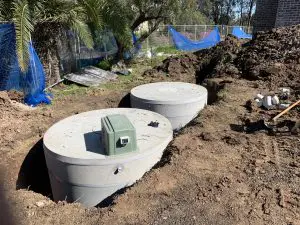Installing an AWTS: What to Expect and How to Prepare Your Property
If you’re considering installing an Aerated Wastewater Treatment System (AWTS) on your property, whether as a new installation or a replacement for an old septic system, there are several factors to take into account. While AWTS are an eco-friendly and efficient option for wastewater treatment, the installation process requires some thoughtful preparation and planning to ensure everything goes smoothly.
In this guide, we’ll walk you through what to expect during the installation of an AWTS, the steps involved in preparing your land, the necessary permits and approvals, and tips for maintaining your system once it’s in place. Whether you’re building a new home or upgrading an existing system, understanding the logistics of installing an AWTS will help you make informed decisions and avoid unexpected challenges.
What is an AWTS and Why Install One?
An Aerated Wastewater Treatment System (AWTS) is a modern wastewater treatment system that uses oxygen to accelerate the breakdown of organic waste. It’s an ideal solution for areas where traditional septic tanks may not be effective or feasible. AWTS are often used in areas with high water tables, poor soil conditions, or small lot sizes, as they treat wastewater more efficiently than conventional systems and require less space.
Compared to septic tanks, AWTS offer several advantages, including:
More efficient treatment of wastewater due to the use of aerobic bacteria.
Smaller footprint that can be ideal for properties with limited space.
Eco-friendly disposal options that meet modern environmental standards.
Improved performance in areas with challenging soil conditions or water tables.
With all these benefits in mind, it’s important to ensure that your property is properly prepared for the installation of an AWTS.
Site Preparation: Getting Your Land Ready
The first step in installing an AWTS is preparing your land for the system. Proper site preparation is essential for the system to function efficiently and to avoid costly complications during or after installation. There are a few key elements to consider when preparing your property:
Soil Testing
Before installing an AWTS, it’s critical to conduct soil testing. The type of soil on your property will determine whether your land is suitable for the system and how it needs to be installed. Soil tests will assess factors like:
Percolation rate: how quickly water drains through the soil.
Soil composition: the ratio of sand, clay, and silt in the soil, which affects water filtration.
Groundwater levels: areas with high groundwater may require special considerations, like an elevated treatment system.
Soil testing will help determine if the land can support an AWTS and whether additional treatment measures or special installation techniques are necessary.
Space Requirements
AWTS systems come in different sizes, but most will require a certain amount of space for installation. You will need an area that’s large enough for both the treatment tank and any necessary drain fields or disposal areas. These systems also require sufficient access for maintenance and repair, so plan to keep the installation site clear of obstacles such as trees, fences, or large structures.
Be sure to consult with your AWTS provider or installer about the exact space requirements for the system you’re considering, as different models may have different needs.
Necessary Permits and Approvals
Installing an AWTS is a major construction project that typically requires several permits and approvals before work can begin. These permits will vary depending on your location, so it’s essential to check with your local council or regulatory authority to understand the specific requirements for your area.
Key Permits You Might Need:
Building permit: Some areas require a building permit for any new system installations, including wastewater treatment systems.
Plumbing permit: This may be necessary if any plumbing work is required to connect the AWTS to your home’s plumbing.
Environmental permits: In some areas, particularly environmentally sensitive regions, you may need permits to ensure that your AWTS meets local environmental standards.
Health department approval: Depending on local regulations, you might need approval from the local health department to ensure the system meets health and safety standards.
Work with your installer to ensure that all permits are obtained before construction begins. Failing to get the proper approvals could result in fines or delays and potentially force you to remove the system if it’s found to be non-compliant.
Timeline for Installation
The timeline for installing an AWTS can vary depending on a number of factors, including the complexity of the system, the size of your property, weather conditions, and local regulations. However, a typical AWTS installation might take anywhere from 1 to 3 weeks.
Key Phases of Installation:
Preparation: This phase involves completing soil testing, obtaining permits, and preparing the land. Depending on the complexity of the site, this can take several days to a week.
Excavation and Tank Installation: After preparation, the site will be excavated to make room for the AWTS tank and related components. This phase usually takes about 2-3 days.
System Connection and Testing: The system will be connected to your home’s plumbing, and the treatment system will be tested for functionality. This typically takes another 2-3 days.
Final Inspection and Approval: After the installation is complete, a final inspection may be required to ensure everything is up to code. This could take a few additional days.
It’s important to note that weather conditions (such as rain or snow) can affect the timeline, as well as any delays in obtaining necessary permits. Be sure to have a discussion with your installer to get a realistic time estimate based on your specific site.
Choosing the Right AWTS for Your Property
Not all AWTS systems are the same, so it’s important to select a system that fits the specific needs of your property. Here are a few things to consider when choosing the right AWTS:
Property Size and Occupancy
The size of your property and the number of people who will be using the system are key factors in determining the size of the AWTS you need. Larger households or properties with more water usage will require a more powerful system to handle the increased flow.
Local Regulations
Make sure the AWTS you choose complies with local regulations and environmental standards. Some areas may have restrictions on the type of system you can install, especially if you’re near water bodies or in sensitive environmental zones.
Environmental Considerations
If you’re looking for an eco-friendly option, check for systems that are energy-efficient, use sustainable components, and have a minimal environmental footprint. Some AWTS systems offer features like solar-powered aerators or low-energy pumps, which can reduce your system’s overall energy consumption.
Budget
AWTS systems come in a range of prices, depending on size, complexity, and features. Be sure to factor in the cost of installation, as well as ongoing maintenance costs, when choosing the system that best fits your budget.
Post-Installation Maintenance: Keeping Your AWTS in Top Shape
Once your AWTS is installed, ongoing maintenance is essential to ensure it operates effectively and efficiently over the long term. Here are a few key maintenance tasks to keep in mind:
Regular Inspections
AWTS systems should be inspected regularly to ensure everything is functioning as it should. Typically, an annual inspection by a professional is recommended. During this inspection, the system will be checked for any blockages, leaks, or damage.
Cleaning and Servicing
The aeration chamber of the AWTS should be cleaned and serviced periodically to ensure that the aerobic bacteria continue to work effectively. Depending on the model and usage, this may be required every 1-3 years.
Pumping the System
Just like traditional septic systems, AWTS systems need to be pumped occasionally to remove sludge buildup. While AWTS are generally more efficient at breaking down solids than septic tanks, regular pumping is still necessary to prevent backups and keep the system running smoothly.
Installing an Aerated Wastewater Treatment System (AWTS) is a great option for homeowners who want an efficient, eco-friendly way to manage wastewater on their property. With the right preparation and understanding of the process, you can ensure that your installation goes smoothly and that your system remains operational for years to come.
From site preparation and choosing the right system to securing permits and scheduling installation, planning ahead will help minimize any surprises. Don’t forget to stay on top of routine maintenance to keep your AWTS working efficiently long after the installation is complete. With proper care, your AWTS will be an effective and sustainable part of your property’s infrastructure for many years.
Related Posts
- The Ultimate Guide to Maintaining Your AWTS System
- How Do Grey Water Recycling Systems Work
- STOP Flushing These 12 Things Down Your Drain:Protect Your Pipes
- Cracking the Code: Understanding Water Quality Standards in Australia
- What are the different type of commercial wastewater treatment systems
- Terrick Rural Services
- How to Make Sure You Have The Right Wastewater Tank For Your Home
- Why should effluents be treated before discharge?




